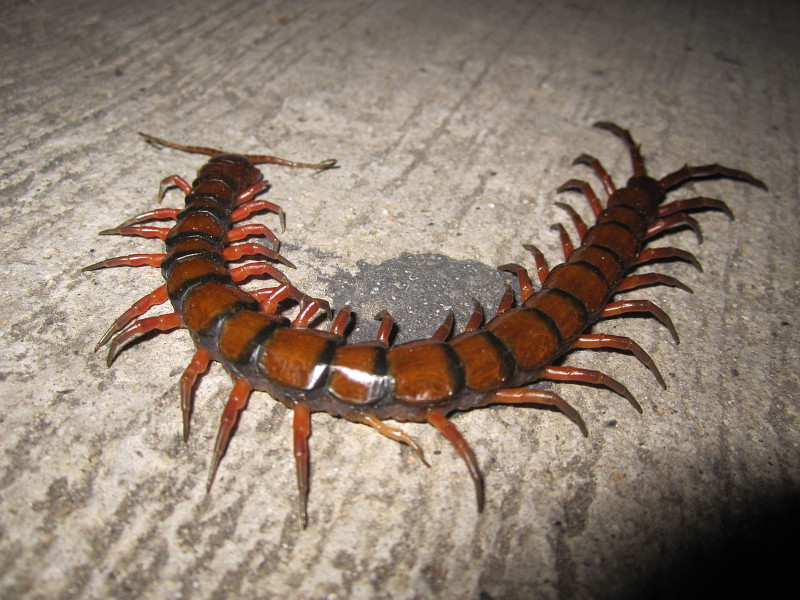Amazonian Giant Centipede Facts
- This astonishing arthropod most frequently goes by the aptly descriptive common name of the Amazonian Giant Centipede. It does, however, have an alternate common name often applied to it. That’s the term of the Peruvian giant yellow-leg centipede.
- Both somewhat lengthy terms descrive the creature well. Its scientific name, meanwhile, remains that of the Scolopendra gigantea. The Swedish researcher Carl Linnaeus made the first formal acknowledgement of it as a distinct species in 1758.
- Classified as what scientists list as a myriopod, this marvel of Nature’s well known for several reasons. That’s due to the fact that it stands out among its kind for its size and behavior patterns. It’s the largest known of its genus, and among the most aggressive.
- For the moment, it appears to be maintaining a population base that’s both stable and sufficient. The IUCN, therefore, presently has no listing for it on the organization’s Red List of Threatened Species. That status could change in the near future, though.
- Due to the nature of its habitat, and native range, the amazing Amazonian Giant Centipede remains potentially vulnerable to several threats. Habitat loss certainly forms one of these. Like many species, though, climate change represents a growing danger.
Related Articles
Amazonian Giant Centipede Physical Description
The fabulous Amazonian Giant Centipede astounds those who encounter the arthropod in its natural habitat. Typically, the first trait of the creature noticed in such encounters is the sheer size. That further holds true for both genders of this amazing marvel of Nature.
That’s because, unlike many invertebrates, it displays not noticeable sexual dimorphism. This includes in terms of both sheer size and physical appearance. Mature adults of both genders, therefore, attain an average body length equaling approximately 12 in (30 cm).
The body develops in a highly elongated shape. It’s further divided into multiple, clearly defined sgements. Like its many relatives, each segment possesses a single pair of legs. The total pairs range in number from 21 – 23, and varies between individuals regardless of gender.
Incredibly, the legs on the leading segment evolved into venom-bearing fangs! Yet another pair of forward legs evolved into mandibles that pose a dual threat. That’s because they’re not only powerful, but also contain venom glansds themselves, to attack its prey.
Distinctively, the coloring of the Amazonian Giant Centipede also varies among individuals, regardless of gender. Colors include combinations of shades of red, brown, black, and yellow. Dark stripes appear between the segments, and the legs appear bright yellow.
- Kingdom: Animalia
- Phylum: Arthropoda
- Class: Chilopoda
- Order: Scolopendromorpha
- Family: Scolopendridae
- Genus: Scolopendra
- Species: S. gigantea
Amazonian Giant Centipede Distribution, Habitat, and Ecology
The amazing Amazonian Giant Centipede evolved as native to a moderately expansive portion of the world. That’s because it appears in the northern portion of the continent of South America. That range include such countries as Colombia, Venezuela, and Brazil.
Scattered individuals have, however, been accidentally introduced into other countries in the region. These include Hispaniola, Mexico, Puerto Rico, and the Honduras. It’s assumed that these introductions occurred accidentally, perhaps via shipping activities.
The creature does have decided preferences where its choice of habitat is concerned, though. Its own name provides a clear indication of this, in fact. The majority of individuals live either in or near the Amazon rainforest. It prefers either tropical or sub-tropical areas.
Like its many related species, it evolved as a carnivore. It, however, takes that to another level. The invertebrate displays extremely aggressive tendencies, having no fear of attacking creatures far larger than itself. It rarely attacks, however, unless in hunger or if provoked.
Regarding prey, the Amazonian Giant Centipede also shows no apparent fear of larger species. It feeds on virtually any creature it can overpower. This most commonly includes such varied invertebrate prey as large insects, spiders, scorpions, and even tarantulas.
Occasionally, however, it kills even larger vertebrate prey, such as frogs, lizards, mice, small snakes, and birds. It’s even been spotted, on occasion, attacking and killing bats, as they hang from their perches. It’s own predators include larger birds, snakes, and other mammals.
Species Sharing Its Range
Check out our other articles on 5 Splendid North American Spiders, Blue Footed Booby, Black Witches’ Butter, Macquarie Island, Kerengga ant-like jumper, California red-sided garter snake

